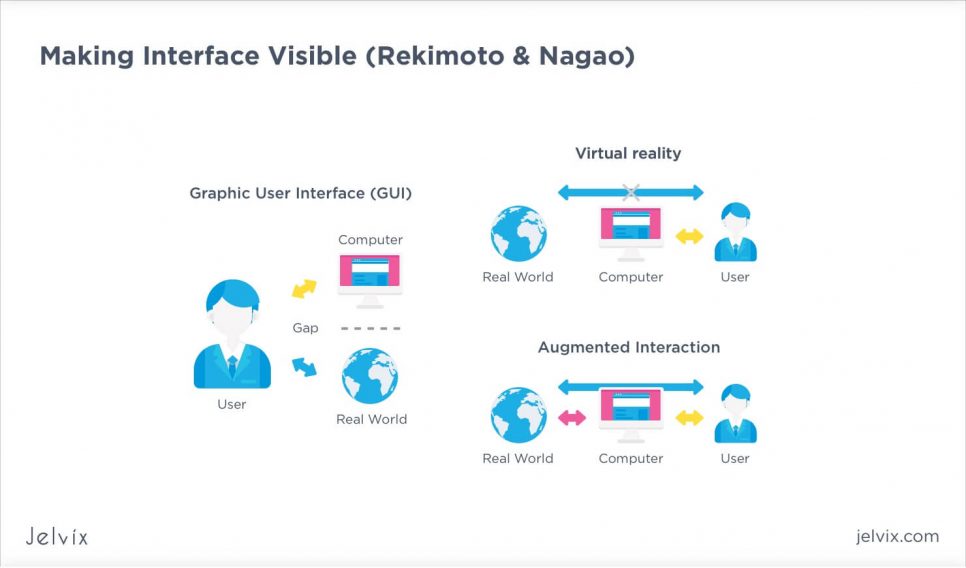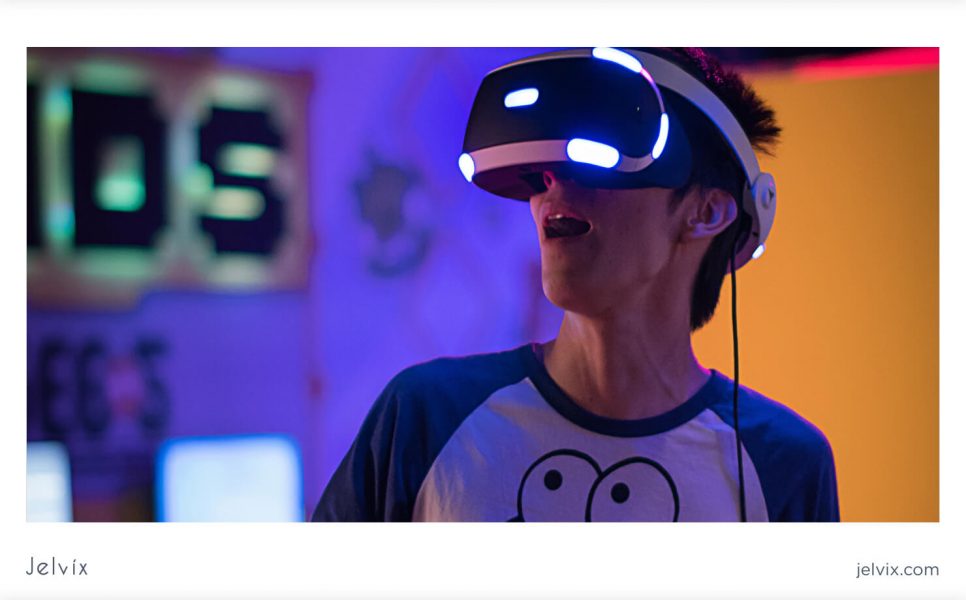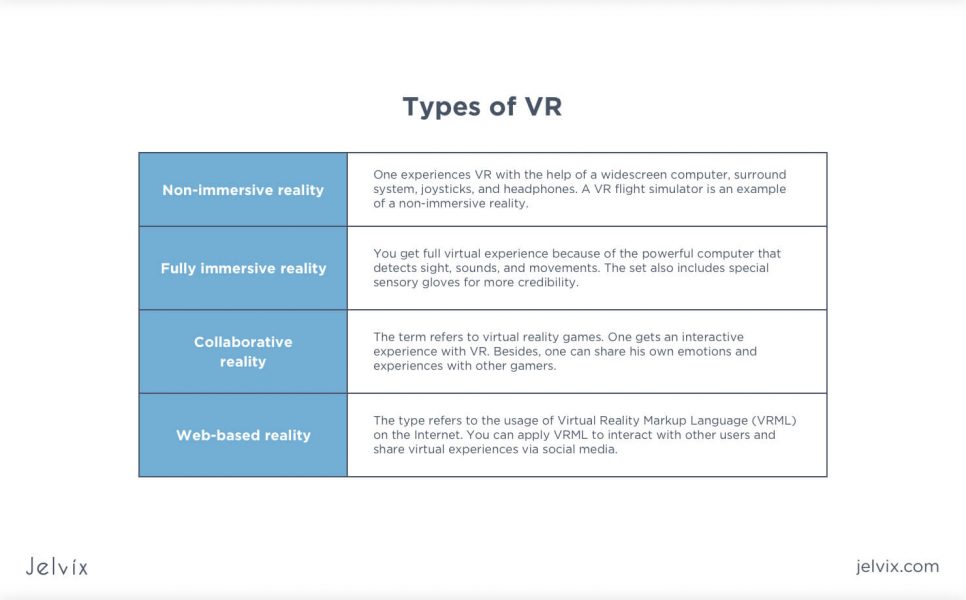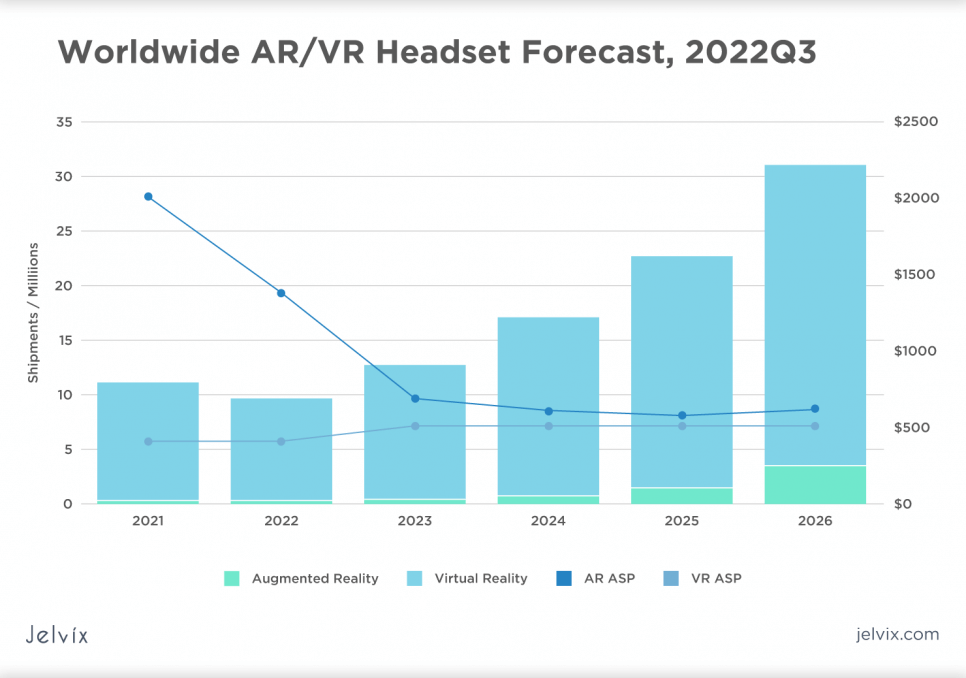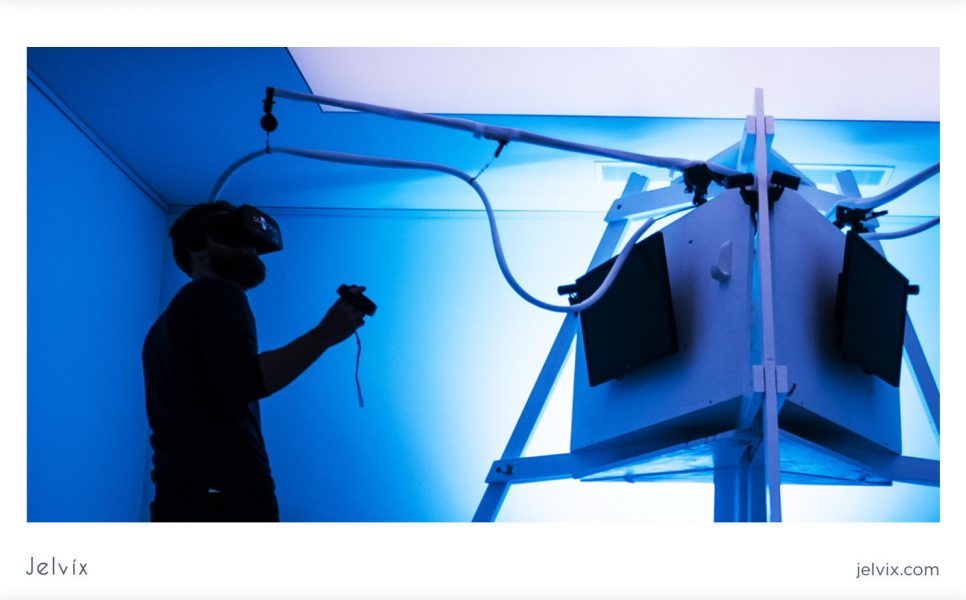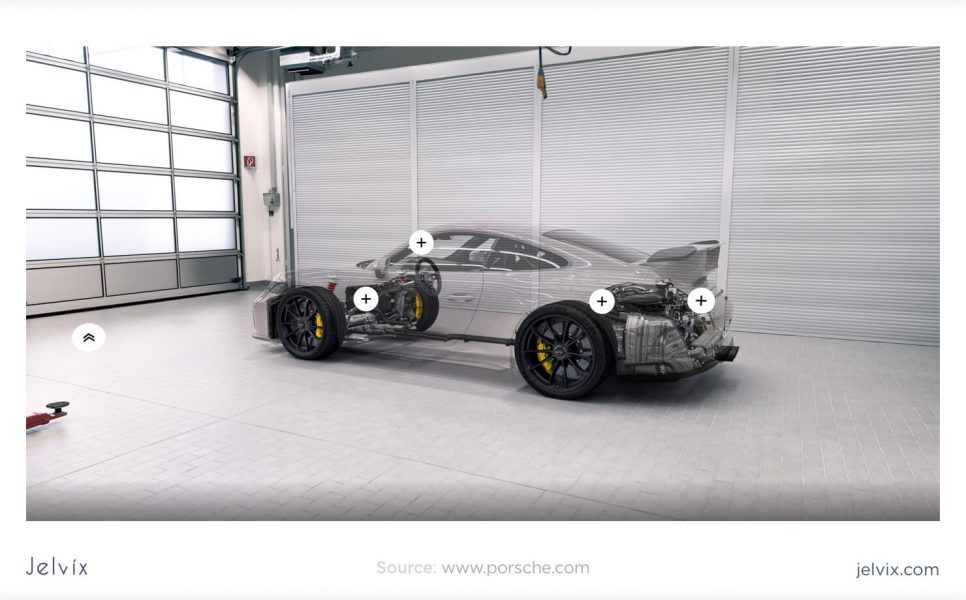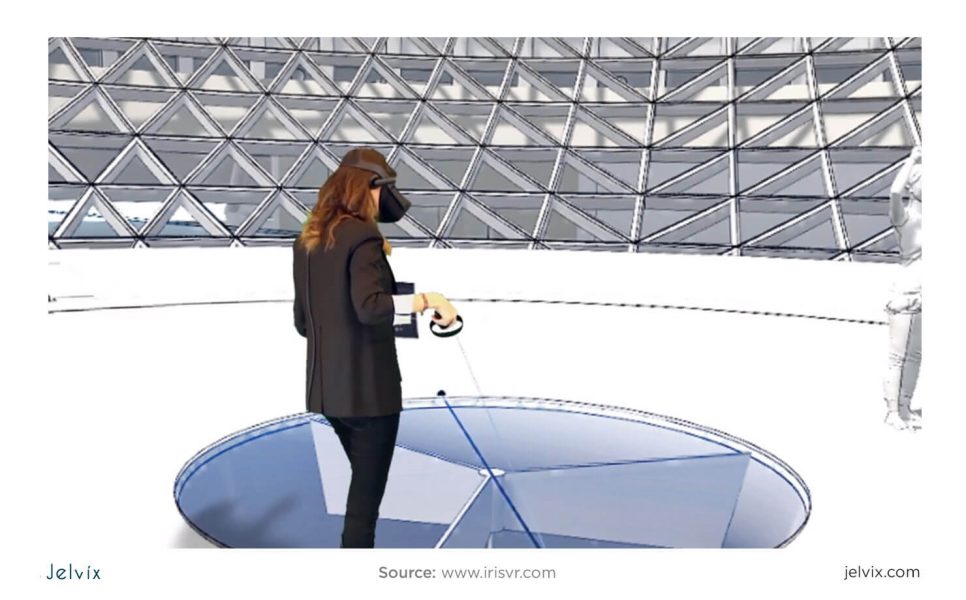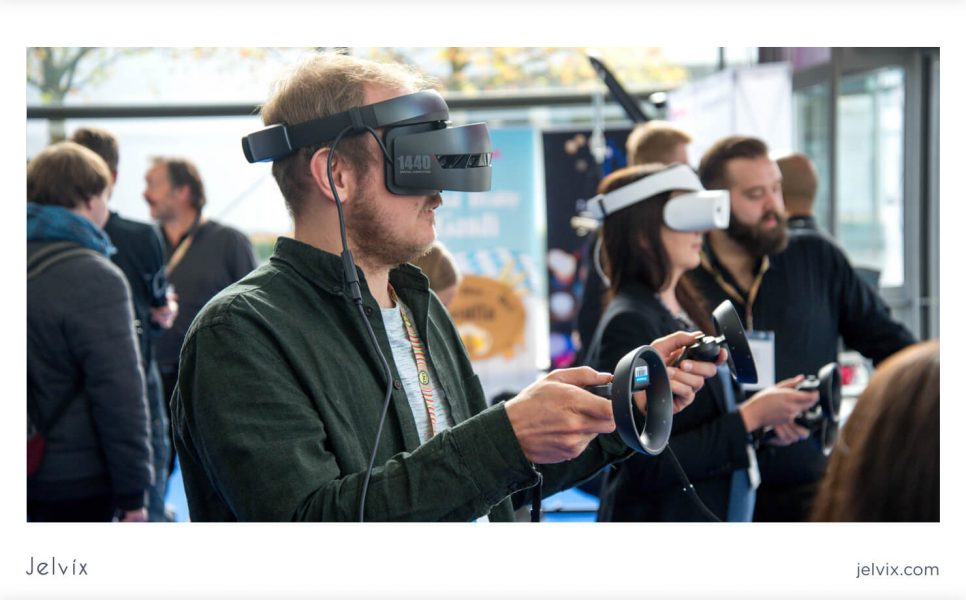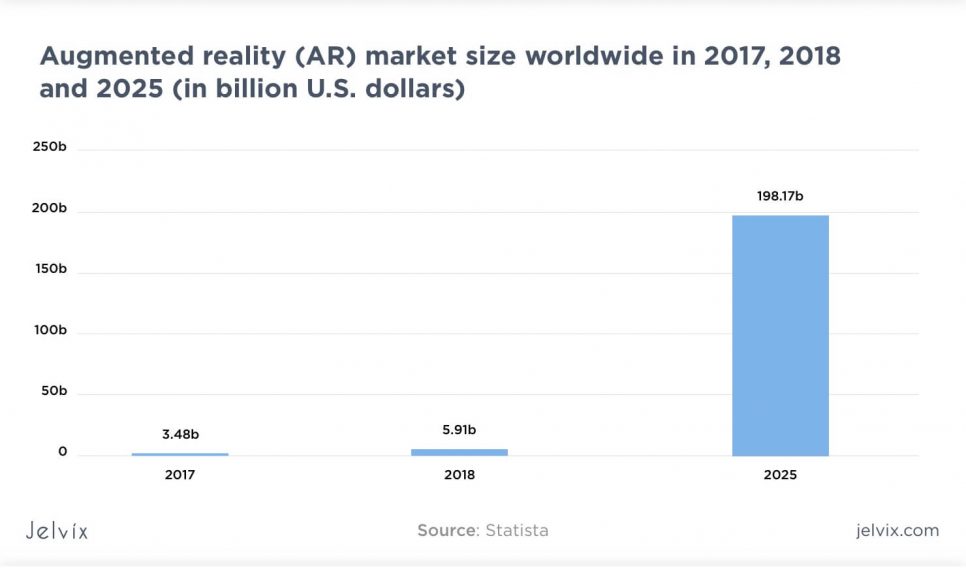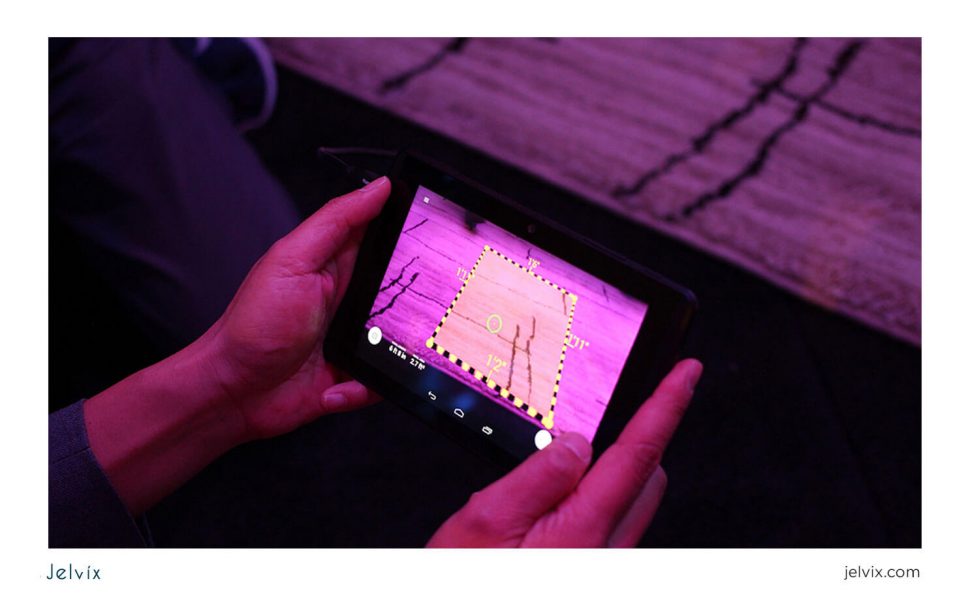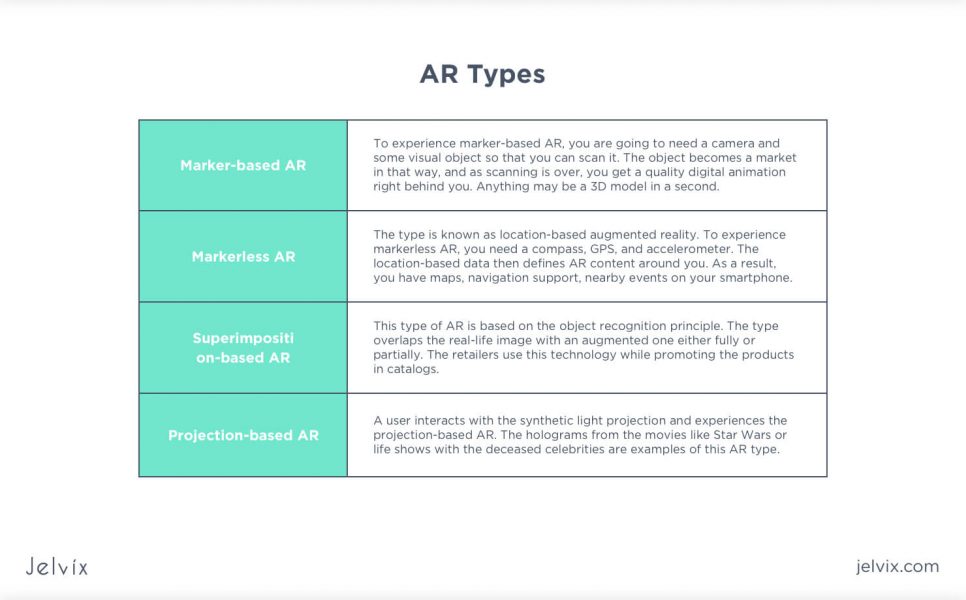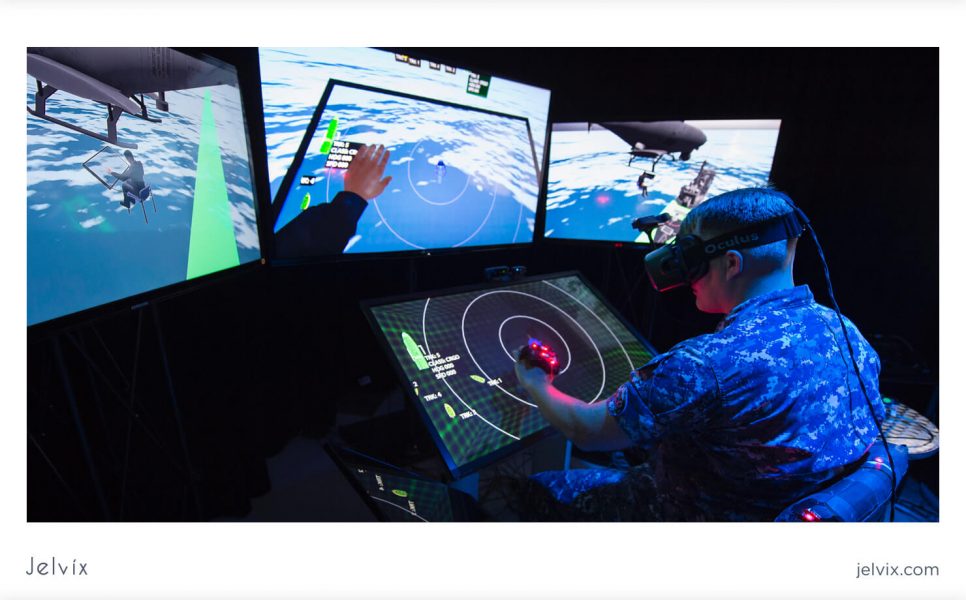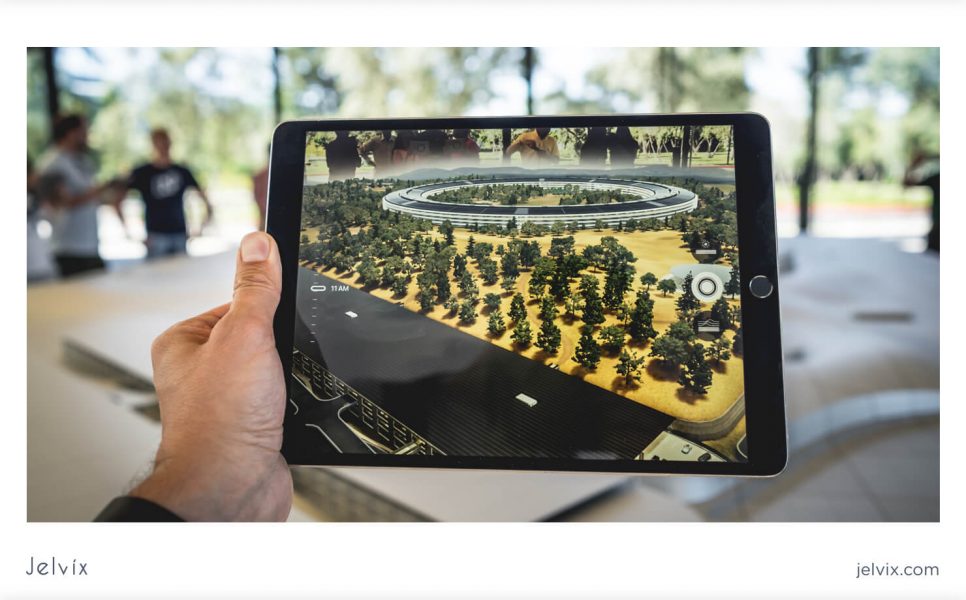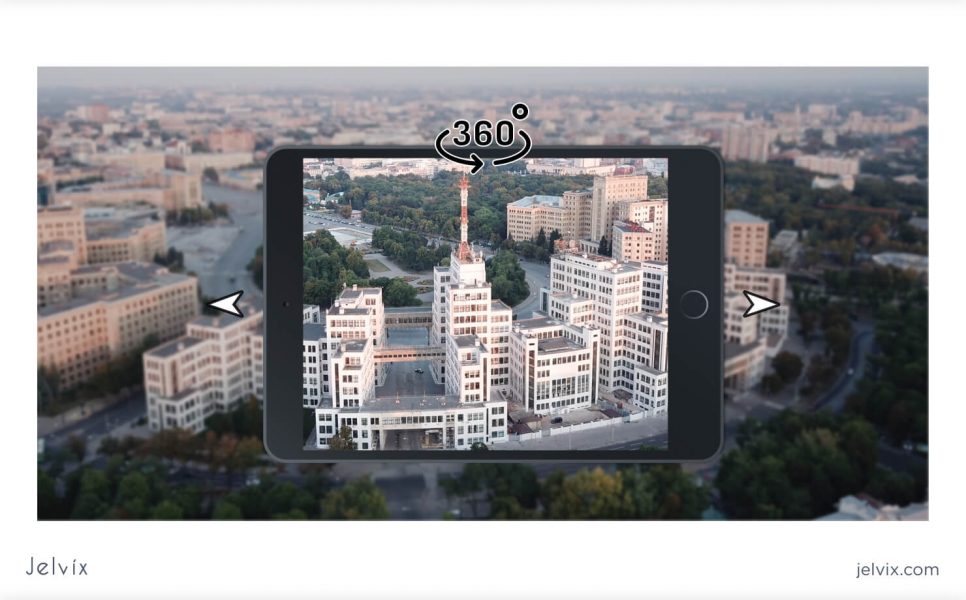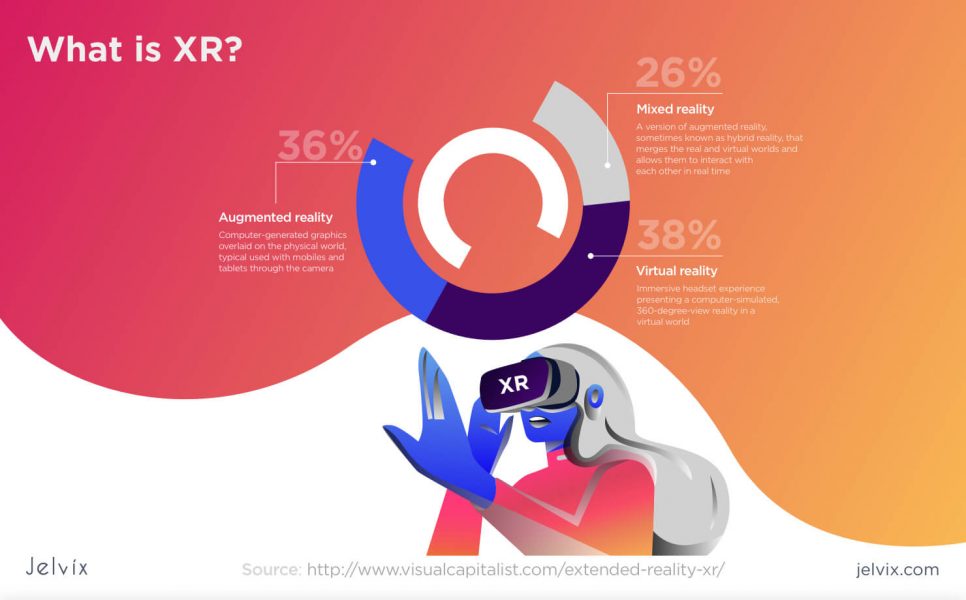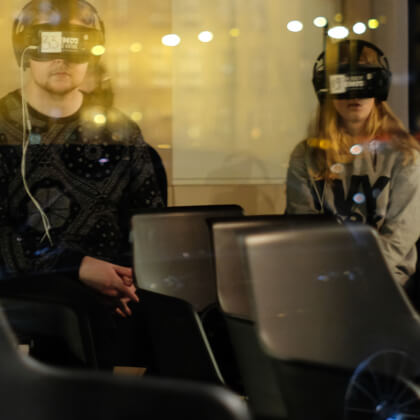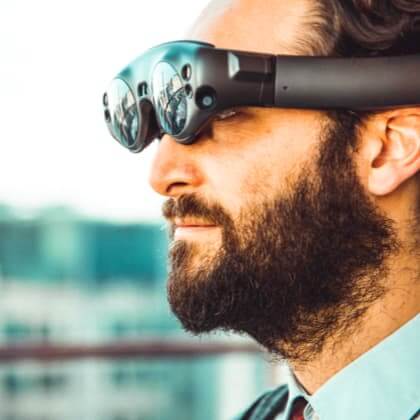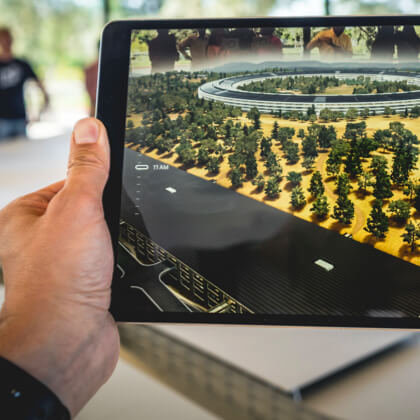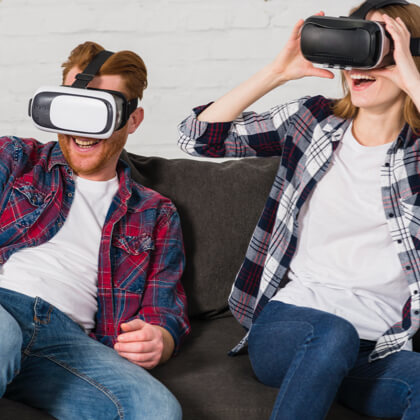Nowadays, we often come across such terms as virtual reality (VR), augmented reality (AR), and mixed reality (MR). These acronyms are not new to the world. However, some people still can’t define what these expressions mean and what is the difference between AR, VR, and MR. We’ve decided to help you figure out the meanings of all these terms and provide a brief explanation of VR vs. AR vs. MR.
Also, we’ll take a look at the differences between real-reality (RR) and extended reality (XR) and see what threats and opportunities digital reality provides to our actual lives. By the look at current market tendencies and technology progress, it seems that AR, VR, and MR aren’t mere buzzwords, but game-changing innovations that already impact our routines and businesses.
The immersion effect seems to be a clear concept, but many people still don’t understand it. Immersion effect is a term that came from the movie industry and meant a state in which users forget whether they are in the real world or not. So there’s no surprise that lots of technological solutions have become desired in the business world as well. So VR, AR, and MR are not exceptions.
What is VR?
Virtual Reality (VR) creates an alternative reality, displayed with the help of helmets or smartphones. It can be either linear video or 3D simulations. The significant aspect is the effect of the presence and sensation of the immersion into another space. Thus, anything that might embody the fantasy of a writer, designer, or developer.
Due to the different angular displacements for the right and left eyes, viewers can see a voluminous picture. The positioning sensors in the displaying device help to transfer any movement of the viewer to the virtual world. As for the most recognizable VR component, one should mention the head-mounted display or simply HMD.
VR helmet aims to block the real physical environment so that a user becomes separated from the field of vision. Thus, you enter a three-dimensional world and can experience several new activities. Besides, to try the effect of the three-dimensional video, you don’t even need to have virtual reality glasses. You can change the viewpoint by swiping the screen with your finger or with a mouse on your PC.
VR devices like Oculus Rift and Samsung Gear VR had caused quite a stir back in the day. Now, when this technology has established itself, there is no lack of offer on the market. HTC Vive, Oculus Quest, Valve index – to name a few. Add to these offerings from every other major consumer electronics manufacturer: like HP, Dell, or Acer, and it becomes clear that the market for VR headsets is booming.
VR-content that responds to user actions is called interactive. It can be found in many computer games and even in mobile games. Usually, to start interacting with the content, a person needs to look in a particular direction.
Moreover, if the viewer has a unique controller, they can select, move, change, and delete objects without using the context menu. It sounds like real magic; however, it is what makes VR popular among the users.
VR technology requires high-quality audio effects to add credibility. While good graphics is essential, hearing is precious for the users who are eager to experience a new space. No wonder that people react to sounds more responsive than to images. Thus, specific spatial characteristics seem to be a critical factor. You can understand what it means while watching this impressive audio infographic.
Use of VR
A video game industry benefits from VR a lot since the appearance of the technology. Nonetheless, virtual reality becomes more sophisticated, functional, and wanted in diverse fields. At the time of 2023, VR is being used for education, marketing, training, and engineering.
While the prospect of this technology is impressive, and VR undoubtedly is going to take its place in many different applications. Everyone still waits for an application that can make a beachhead large enough for steady progress and development. We have mentioned the prospects of VR technology in our blog post about the future of virtual reality.
Training and education
The most amazing thing about training with the help of VR is that you can practice as many times as you need without risks. A user can experience extreme sport to the fullest degree.
The technology fits those who don’t have any profound experience or skills. Isn’t it exciting to become a pilot for a moment or experience a parachute jump without being afraid of the outcomes? VR is a proper solution for those who have aerophobia.
On the other hand, VR is a training tool for the experienced specialist as well. For instance, soldiers can conduct raids in virtual reality. Also, surgeons can perform operations using virtual patients. VR training enhances the skills of the users and also adds to their confidence as a specialist.
Thanks to VR technology, students don’t have to bother if they cannot attend classes due to personal circumstances. In 2023, students can feel as if they are present in the classroom when using VR technologies. Home-based learning might be burdensome. So a VR solution allows one to stay present during a lecture. With the help of VR, students can no longer be distracted from the learning process.
For instance, an art school from a small city of Middletown, Ohio, uses VR in its teaching programs to great effect. New technologies help them to both entice new digital generation and prepare them better for the future. VR seems to be the way forward into the world of 3D design, so artists and designers with this skill set might have an edge on the market in the next 10 years.
Marketing
A virtual pleasure has found its place in marketing as well. Today, marketing specialists apply VR to let you make a virtual purchase. The positive side of such a scenario is evident for both parties. On the one hand, retailers use VR to promote a product or service. On the other hand, to make users spend their money before they try out a product or some innovative service.
Real estate is a big niche that benefits from using VR technology a lot. Buying a home or an apartment is a serious step in your life, and you want to make sure that this choice is right, and you won’t regret it. For that reason, VR lets you buy a new house, wander around your virtual home, and experience living there. Thus, you save not only your money but also time.
Developing your own VR experience to promote your brand might be an expensive proposition. However, many companies are considering this as a good investment in their brand.
Automotive giants lead the way in this regard as a brand image is extremely important for that industry. Porsche presented their VR experience on a recent auto show. Land Rover soon followed this trend with its new Defender VR presentation.
But it’s not only automotive producers that invest in their VR presentations. Walmart, among others, has launched a VR promotion campaign in its stores. The application ‘How to Train Your Dragon’ was made in cooperation with a 3D animation powerhouse DreamWorks Animation.
However, VR is not only for expensive brand image campaigns. Many successful ventures pop up around serving ads on existing applications, showing intriguing engagement numbers.
Engineering and design
Engineers and designers apply VR technology to visualize while constructing 3D models. Sometimes, it can be rather hard to realize how your project looks like in reality. So engineers and architects resort to create a prototype and sift through an object. After this, it is possible to either start the implementation or make some amendments. Such use of VR is especially money-saving.
Before the construction of the real estate objects, a specialist examines the object from all possible angles. Applying the full 360 views, you can zoom up all the details from any party. What is more, with the scientific technologies available in 2023, we can go even further. By using real-life physics, we understand how virtual models respond to such elements as water or wind.
VR is useful for both polishing out a project and demonstrating projects to clients who might not necessarily get the proper impression from the CAD document. A good example of this is IrisVR. It’s a software that integrates with other popular architecture and design programs and allows for visualizing projects in VR.
What is AR?
What does AR stand for in technology? Augmented reality allows overlaying real objects with some virtual content. AR has many use cases, but the most famous one is the AR games. The user experiences a computerized simulation via the animation, images, and sound techniques. The AR set includes special glasses, a hand-held gadget, and also powered display surroundings.
Most modern smartphones and tablets support AR applications. There are also specialized devices like Google Glass, and Microsoft HoloLens intended for enterprise primarily.
Apple is also big on the AR smart glasses concept, and its device is forecast to hit the market in early 2026. There are offerings from other big consumer electronics manufacturers, but the market for smart glasses is somewhat less prolific than the market for VR headsets.
The possibilities of augmented reality are limited only by the hardware capabilities as of now. Thus, a display environment overlays the real-life images of augmenting reality. The first-ever AR app was a native application for smartphones.
The mobile app worked on the principle of adding textual overlays to the image from the camera. Back in the 2000s, AR tennis game for Nokia became one of the first-ever smartphone AR apps.
Google project ‘Tango’ made a massive contribution to the development of AR technologies. The project was developing hardware, as well as software for smartphones. Devices that support Tango have sensors for processing data of the exact locations of the surrounding objects. By the way, we have covered tools available for AR development in 2023.
Use of AR
Military and medical use of AR
People with armed forces and medical workers apply AR in practice. Jetfighter pilots apply the Heads-Up Display (HUD), which comes in the form of a transparent display. It includes such critical information as airspeed, altitude, horizon line, and some more. The convenience of this is that all the displayed data is right in front of the pilot’s eyes.
Red 6 Aerospace’s software is used by the US Air Force to a greater effect. It improves training efficiency and safety as it simulates opponent air presence without a need to use real planes and pilots. Fewer planes in the air during training means there are lesser chances of a collision or malfunction. It also saves taxpayer money.
As for the medical use of AR, you cannot but mention neurosurgery and application of this technology in it. Modern neurosurgeons can carry out complicated operations using 3D images with precise coordinates. So, during brain operations, a doctor has information, based on the actual anatomy of a concrete patient.
If you want to know more about medical software development, read our overview of the role of app development companies in medical diagnostic.
Maintenance and repair
With the help of AR technology, a mechanic can execute complicated repairs. AR allows to label some critical elements and parts, while the superimposed images come in handy during the repair works. AR helps to carry on some construction works by breaking down the entire procedure into separate steps. Besides, the engineers can be trained, using AR simulations.
Mechanical engineering and maintenance work is often about the experience and visual imagination. A mechanic needs to know the dimensions and properties of all parts of the mechanism. When he doesn’t – mistakes happen. AR allows a handy lookup for specs of the parts, allows a quick gauge of mechanical parts without other tools, and can give a better image of the innards of an unfamiliar mechanism.
There is an interesting test implementation of this concept in the Belgian ARIA project by Imec R&D company, Ghent University, and Viu More. Here is a video presentation of it.
AR Gaming
AR gaming becomes more exquisite year by year. No wonder that AR is mostly associated with the niche of virtual gaming. With innovations available in 2023, AR games are affordable as never before. As a bonus, there is no need to use your PC to enjoy a new experience. Anyone can install the corresponding mobile app and start a virtual journey straight away.
The sensational success of a Pokémon GO game proved the viability of the AR game concept in spades. It made well over 3 billion US dollars in total, making it one of the most successful games in history. After a sensation like that, there is hardly any doubt about the future prospects of AR gaming on mobile.
Unlike VR, AR struggles when it comes to console and desktop market. AR gaming remains a primarily mobile experience. Also, while a mobile market share of overall gaming revenue is immense, it still suffers from being sidelined to the periphery. Maybe AR is going to be that thing that is going to push the mobile market into the forefront of excitement and innovation? Only time can tell.
AR in business
We have already covered the business applications of AR in this article on the top 5 ways to use augmented reality for business. However, to reiterate, the main uses are:
- Interior design;
- Virtual dressing rooms;
- Tourism-related usages;
- Advertisement and marketing;
- Data visualization.
What is MR?
And finally, what is mixed reality? MR or mixed reality indicates videos where VR-content is integrated into a real-time linear video. The shooting of an actor in VR is conducted by using the Chroma Key technology. In this case, the position of the camera is aligned with the location of an actor. As a result, viewers, experiencing MR, can see the actors as if they are in an artificially created environment.
Use of MR
Thanks to the exceptional mix of AR and VR technologies, MR gains momentum with every year. MR has become an efficient tool among the average users, corporate leaders, and public sector employees.
Corporate world and MR
Modern entrepreneurs keep their hands on the pulse of technologies that can solve their issues. Big corporations make a significant amount of money and, correspondingly, are eager to invest in something that is going to pay off. So MR has a high potential for that.
For instance, Renault Trucks manufacturer successfully applies MR technology in real life. The company resorted to HoloLens to refine the quality control of the engine build-up operations. The operators put on the smart-glasses to see a digital version of the engine parts. So engineers were able to execute all the problematic control operations.
MR and business training
MR is often seen as a demanded technology for experiential training by businesses. Managers need to carry out training sessions for employees to learn how to act in a situation that is likely to happen in real life. MR offers a simulated environment that excludes risks and prevents unwanted scenarios.
For instance, East Nippon Expressway Co decided to use MR to train tollroad personal. Applying MR in safety for operation training makes this arguably dull and tedious affair more interesting and effective.
Learning with MR
MR offers a fully immersive experience that changes the way you used to study. The students need a head-mounted display and motion controller. The devices favor your interaction with the environment that is a blend of the virtual and real worlds and objects. The most exciting thing is that you can interact with abstract concepts, complicated formulas, and even touch an object!
It is possible that MR and AR will finally make headway in developing training methods for people with low IQ, making an employment market accessible to them. Almost 60 years after US President Lyndon B. Jonson and State Sec. Robert McNamara tried to use video courses to train mentally challenged people. Technological development finally turns this dream into a possibility.
Designing in MR
Designers use MR technology to review their projects in advance. Before the beginning of a construction project, an architect or a designer could make a demo. Sketches and models have been used for that throughout history. However, models and sketches rarely represent the real scale and size of an object. With MR, the aesthetic impact of a building or an interior can be assessed as if it was already built.
VR vs. AR vs. MR: what is necessary to remember when making content?
- In the augmented reality vs. virtual reality issue, videos can grab the viewer’s attention immediately. More exciting and believable content is going to be watched more. Content is a significant point for those who want to use VR vs. AR vs. MR in their business effectively.
- The professional shooting of panoramic video isn’t an easy task. Since viewers must have the capability to change their viewpoint, the shooting equipment and props mustn’t fall into the frame.
- For the audience to truly feel what is happening, every detail, its place, and meaning is vital as it helps to plunge in the virtual world.
- The scene transitions should be as smooth as possible to make virtual reality look natural. A smooth transition has a significant meaning as it allows viewers to get used to changes and orient in new scenes.
- Panoramic shooting poses new challenges for filmmakers. Appropriate framing, movement, and animation, as well as sound, helps to attract the viewers’ attention.
Augmented reality, virtual and mixed reality: used technologies
Today, IT companies like Jelvix develop VR and AR applications for smartphones and tablets, using:
- GPS (to locate the current position);
- inertial compass (to determine the direction);
- tracking of text, hyperlinks, videos, and photos in the database;
- screen information composition in overlays.
As for the MR, the technology is headset-based and requires such components as cameras to create the environments that unite AR and VR worlds.
360 video changes the visual medium
360 videos allow viewers to get multi-dimensional experience but taking a full look at the event or situation. The video format became supported by Youtube several years ago, and it attracted multiple brands and Youtube channels.
Samsung made such videos a part of its 360-wearables promotional campaign, giving potential customers an opportunity to explore a realistic ski ride. Warner Bros used the technology to create a promotional trailer for their movie The Conjuring 2, getting more than 8 million views – a great result for a lesser-known release.
Although there are skeptics who speculate that audiences might not be interested in such an innovation long-term, we think that 360 videos have a bright future ahead. To push the technology forward, technology companies can disrupt the market with innovating editing solutions, hardware customizations, and a creative environment for directors and editors who work in the new medium.
In a couple of years, we might see a generation of talented filmmakers and YouTubers who will make 360 videos a typical visual format, not just a buzz innovation.
The real reality remains in focus
As much as virtual reality gets closer to the actual world, it doesn’t mean that real reality will become boring and unnecessary, compared to engaging online experiences. AR, VR, and MR can contribute to making RR better, helping people to find new joys in their daily life.
Sure, there are concerns about real reality’s deterioration. We’ve already seen this with social media. By posting online and communicating via networks, people create their social reality that can be drastically different. On the other hand, social media provided people with real-life opportunities: new jobs immerged, people were able to find real-life connections, and enrich their routine.
Virtual and augmented reality is perhaps bound to go the same road. Although there will definitely be concerns about digital realities substituting actual experiences, most likely, we will find a way to seamlessly combine all kinds of environments.
Ultimately enriching real lives with digital experiences, people will get tangible benefits of this technology – new jobs, high salaries, and physical skills after training or playing in the AR environment.
Read more about the value of customer reviews for the best software development company.
Welcome to extended reality
Extended reality (XR) is the term that describes AR, MR, and VR innovations. XR is the time of environment where real reality is supported by digital worlds, seamlessly integrated with real-life interactions. The actual reality is not substituted by these add-ons, only enriched and taken out of the box.
With extended reality, people will get access to brand new education and entertainment opportunities, gaining experiences that they could never have touched or felt in real life. If now our sensory capacities are tied to audio and visual input only, XR will provide a full picture, completely immersing people into digital reality.
It will support more efficient relearning, exciting gaming, realistic cinema and TV, and enhanced interpersonal interactions between people from all over the world.
Extended reality is an innovation of multiple uses, which is why AR, VR, and MR startups are one of the hottest on the market right now. Users are interested in exploring new virtual possibilities, and investors see the technology’s potential and gladly support promising innovations.
This is perhaps the reason why prominent tech innovations like Google and Apple joined the extended reality race several years ago – and small and medium businesses keep joining the game.
Conclusion
As you can see, VR, AR, and MR technologies are quite complex and different from each other. These technologies allow brands and advertisers to attract the attention of consumers. Thanks to immersion in virtual worlds, users can experience incredibly strong emotions.
If you know how to give these emotions to your audience, you can increase the recognition of your brand. We have already covered the influence of AR technologies on brand recognition.
Extended reality is a promising addition to the real-realty, and it’s already getting closer to users with 360 videos and augmented applications. A fully immersive, realistic experience provides countless opportunities for education, entertainment, advertising, communication, and science.
Realistic simulations enhance online communications, and unforgettable content – this is the future that can be soon brought to us by XR technologies.
Trying to implement these technologies to your business, you should pay much attention to the software. If you want to get high-quality apps, please, meet our experienced and qualified team of developers.
Need a certain developer?
Access the talent pool to scale your team capacity.


